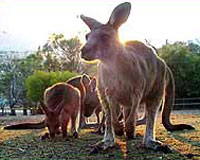Giant kangaroos and lions reigned in Australia before humans burned them
Marsupial lions, kangaroos as tall as trucks and wombats the size of a rhinoceros roamed Australia's outback before being killed off by fires lit by arriving humans, scientists said on Thursday.

The giant animals lived in the arid Nullarbor Desert around 400,000 years ago, but died out around 50,000 years ago, relatively shortly after the arrival of human settlers, according to new fossil skeletons found in caves.
Fossilised remains were uncovered almost intact in a series of three deep caves in the centre of the Nullarbor desert -- east of the west coast city of Perth -- in October 2002. "Three subsequent expeditions produced hundreds of fossils so well-preserved that they constitute a veritable "Rosetta Stone for Ice-Age Australia", expedition leader Gavin Prideaux said of the find, detailed in the latest edition of the journal Nature.
The team discovered 69 species of mammals, birds and reptiles, including eight new species of kangaroo, some standing up to 3 metres (9 feet) tall, Reuters reports.
Any animal, from a tiny lizard scuttling across the hot soil to a giant wombat grazing on grass, could suddenly find itself plummeting to its death through small openings to the caves below.
Life was most risky for the many species of kangaroo, some of them three metres tall, that inhabited the region then, says Dr Gavin Prideaux, of the Western Australian Museum.
"Because kangaroos hop with two feet together, they are committed every time they jump. If they happen to land on a hole, they go straight down."
In 2002 a group of cavers exploring the Nullarbor came across one of these small openings in the ground and abseiled 20 metres through a narrow chimney-like structure into the dark cavern below.
They were the first humans to set foot in the cave, and in the dim light of their headlamps they made an astonishing discovery: the complete skeleton of an ancient marsupial lion, lying undisturbed where it had died hundreds of thousands of years before, smh.com.au says.
The research leader, Professor Richard Roberts, of the University of Wollongong, said that the animals had survived repeated climate change yet had disappeared suddenly in the past 50,000 years.
“Suddenly and during quite pleasant climatic conditions when the megafauna should have thrived, they went extinct. Why? The only new ingredient in the mix at that time was humans,” he said.
“Humans very likely played the decisive role in the extinction event through hunting of juveniles, burning of the vegetation cover and changing the plant composition to disadvantage the browsers and grazers.”
Fossils were first found at the caves in 2002 and although hundreds have been found by a series of expeditions, many more are expected to be dug up in the coming years.
They are adding unpredented detail to scientific understanding of what Australia was like during the Pleistocene era, 1.8 million to 11,500 years ago, the Times reports.
Source: agencies
Prepared by Alexander Timoshik
Pravda.ru
Subscribe to Pravda.Ru Telegram channel, Facebook, RSS!




